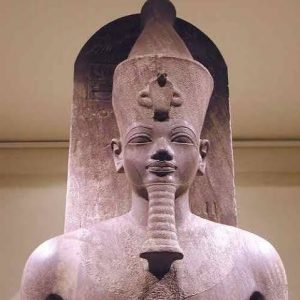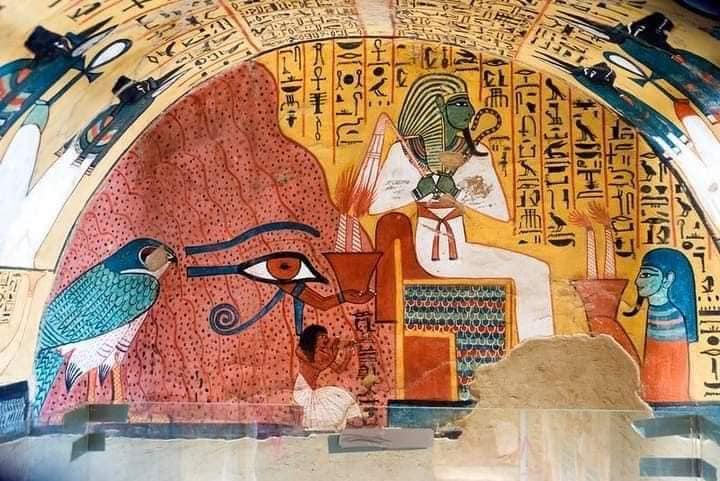The Father of Empires “
“Thutmose III, the master of battles who led 17 battles”
Thutmose III is one of the greatest kings, as he is the owner of the military empire of ancient Egypt and the builder of its most famous temples. He has miraculous personality traits and an unparalleled military genius. Thutmose trained in the battlefields in Luxor, and these exercises earned him a hardness in his personality and great military experiences when she was ruling. Hatshepsut took care of the army, made it regular, and provided it with cavalry and war chariots.
Thutmose III
King Tuthmosis III, the sixth king of the Eighteenth Dynasty, the ancient Egyptians in his reign mastered the manufacture of arrows and arrows, which have become extraordinary permeability recognized by historians today. The statues of Tuthmosis III show us this young man with muscles and possessed the elements of a fighter and a leader, as at the time when Hatshepsut was ruling. It was following a peaceful policy with Egyptian influence in Palestine and Nubia and with its neighbours. It was concerned with the navy and sent naval campaigns to the country of Punt and the coasts of Lebanon for trade exchange. It took advantage of some protectorates in Syria and Mitanni to rebel against the rule of the Egyptians and their hostility. As soon as Thutmose III ascended the throne after the death of Hatshepsut, it was necessary To restore Egyptian control over those hostile movements to secure the borders of the country. Those consequences made him a legendary warrior king who carried out sixteen military campaigns in Asia (the region of Syria and Palestine). They were able to prove his influence and the influence of Egypt as far as Nubia in the south.
The Emir of the city of Kadesh in Syria was leading an alliance of the princes of the Asian countries in the Levant against Egypt, numbering twenty-three armies. It was expected that Thutmose III would support his defences and forces on the Egyptian borders near Sinai. Still, Thutmose decided to go with his huge armies to confront these armies in their lands within A plan to expand the Egyptian empire to the maximum extent possible and secure the borders against the armies of harassers.
Thutmose III was called the “Father of Empires” and “the first emperor in history”. He is considered one of the outstanding geniuses in the history of the military throughout the ages. He was the first to divide the army into hearts and wings. The British Empire used many of its plans in its battles.
Arming and training the army
Thutmose III worked on building castles and fortresses. He trained soldiers in the best exercises and provided them with powerful, innovative weapons such as modern arrows and the expansion of chariots in combat.
What did he do in the battle of Megiddo?
In the Battle of Megiddo campaign, he divided his army into a heart and two wings and used military tactics and manoeuvres that were not known before. Then he rose at the head of his army from the Qantara and travelled 150 miles in ten days, after which he reached Gaza and then travelled eighty miles in eleven days between Gaza and one of the cities. At the foot of Mount Carmel there Thutmose III held a war council with his officers after he learned that the Prince of Kadesh had come to the city of Megiddo and gathered around him 230 princes with their armies and camped in the fortified Megiddo to stop the advance of Thutmose III and his army. There were three ways to reach Megiddo, two of them revolve around the foot of Mount Carmel, and the third is a narrow corridor, but it leads directly to Megiddo. Thutmose decided that the army should pass through the third corridor in an adventure that turned the scales of the battle later, and it is considered one of the most dangerous adventures of armies in the ancient world.
Taking that corridor in advance to the surprise of the enemies required that the Egyptian soldiers carry their military equipment in addition to their war chariots and horses. They were dismantling the war chariots to make them easier to carry. They infiltrated through the narrow corridor in small groups; this was a great risk for the army because Thutmose III used this road to surprise the enemies camped on The next arena on the aisle.
The enemy forces had been stationed at the end of two spacious roads, believing that the Egyptian army would come from one or both of them. At the dawn of the next day, King Thutmose III ordered the army to reinstall the war chariots and prepare for the sudden attack. His forces attacked, and he was at their head in the foreground in the form of a semi-circle on Megiddo, so the surprise was That the Egyptians initiate this sweeping attack, they became upset and lost their balance until their armies became in a state of chaos and disorder, and the leaders of the armies and companies began to flee, leaving behind their large vehicles and their camp full of spoils to enter the fortified city. Because of the Egyptian army’s preoccupation with collecting spoils, the Asians managed to escape to the city and fortified in it.
This is what historians said about Egypt during the reign of Thutmose III
The ancient historians of ancient Egypt said about the strength of Egypt in the era of Thutmose III: “There is no power on earth that can confront the Egyptian army, which received superior military training and won the leadership of a genius king, the great king of Egypt Thutmose III.”
Thutmose III was interested in establishing a powerful naval fleet that could simplify his control over many islands in the Mediterranean, such as Cyprus, and extend his influence on the coast of Phoenicia, “the coasts of Lebanon and Palestine today.” Thus, he was the first to establish the oldest empire known in history, stretching from the upper Euphrates in the north to the fourth waterfall on the River The Nile in the south, and Egypt became the most powerful and richest empire in the world in which the Egyptians lived at the top of their glory and power.
After Thutmose III secured the country and invaded neighbouring countries to prevent their attack on Egypt, he took care of the affairs of managing that vast country that extends from the present western borders of Iraq and northern Syria to the south along the course of the Nile River in the south until the fourth cataract in the middle of present Sudan. He set up each of those countries outside Egypt as a governor from Egypt to rule them and secure the country. The governor helps in governing the country, administrative staff and clerks. The governor was also responsible for supplying the Egyptian army forces stationed there and collecting tribute from the population. The governor was the head of the princes of that country, and when there was a rebellion movement in one of the provinces, the governor was to put it down by Egyptian soldiers.


Comment (0)